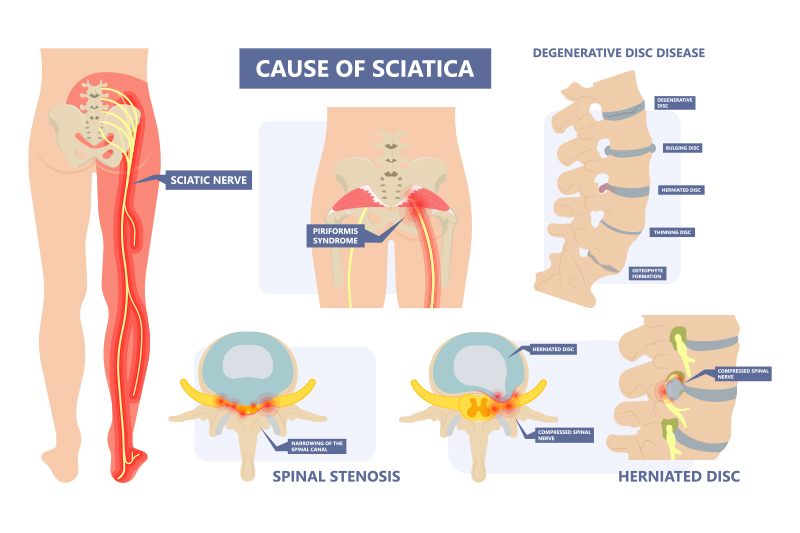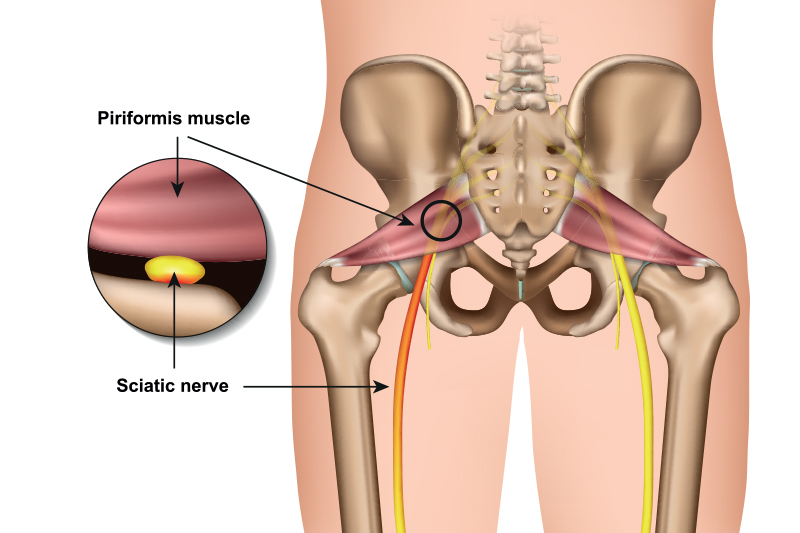Sciatica and Piriformis Syndrome in Beverly Hills

Sciatica refers to pain in the distribution of the sciatic nerve, which starts in the buttocks and travels down both legs. Sciatic pain often gets worse with sitting, especially on hard or uneven surfaces, or with certain activities. Sciatica can be caused by nerve irritation anywhere along the course of the nerve, but is often due to a herniated disc, bone spurs, or soft tissue irritation of the nerve.

Piriformis syndrome is a condition characterized by pain in the buttocks and/or lower back that often radiates to the leg. The condition involves the piriformis muscle in the buttock region. The large sciatic nerve often runs directly next to or through the piriformis muscle, which can cause irritation and compression of the sciatic nerve.
Causes of Piriformis syndrome
This condition is often caused by swelling or spasm of the piriformis muscle which can lead to compression and irritation of the sciatic nerve. Certain structural variations in the anatomy of the sciatic nerve and piriformis muscle can predispose a person to this condition. Often this condition is caused by trauma or sports injuries that involve:
- Trauma to the buttocks
- Strain or sprain
- Overuse injuries
- Hematoma
- Scar formation

Symptoms of Piriformis syndrome
The piriformis muscle aids in the outward rotation of the hip and lower extremity. People with piriformis syndrome often experience reduced range of motion of the hip joint, and reproduction of their buttock pain and symptoms with inward rotation of the hip or when walking up inclines or stairs. Other symptoms may include:
- Buttock pain
- Numbness or tingling in the lower extremity
- Increased pain after sitting for extended periods
- Pain in the low back, thigh, calf, and foot
- Pain with bowel movements
- Pain with sexual intercourse
Diagnosis and Treatment
The doctor will start by taking a detailed history and performing a thorough physical exam. Various diagnostic testing such as MRI, CT scans, ultrasound or EMG (electromyography) may be utilized to gain a better understanding of the location and severity of the problem. Often times, a diagnostic block (injection) can help make the diagnosis. Combining the detailed exam, history and the diagnostic testing will help the doctor in making an accurate diagnosis of the underlying cause of the pain. The doctor will also rule out other conditions such as lumbar disc herniations or lumbar radiculopathy that can produce similar symptoms.
Most initial treatments for piriformis syndrome aim at gradually stretching the muscle through therapy or a home exercise program in combination with anti-inflammatory medications. If conservative management fails, therapeutic and diagnostic injections may be considered. The injection of a local anesthetic and corticosteroid directly into the piriformis muscle can help reduce pain and spasm which may facilitate therapy. If piriformis spasm is persistent, botulinum toxin (Botox) injections may be used to help the muscle relax and reduce pressure on the sciatic nerve. In rare cases, surgical decompression may be indicated.
At Orthopedic Pain Institute, we will develop a highly specialized plan to treat your individualized needs. Schedule your consultation today to learn more about sciatica and piriformis syndrome and how we can help you get back to what you love!


